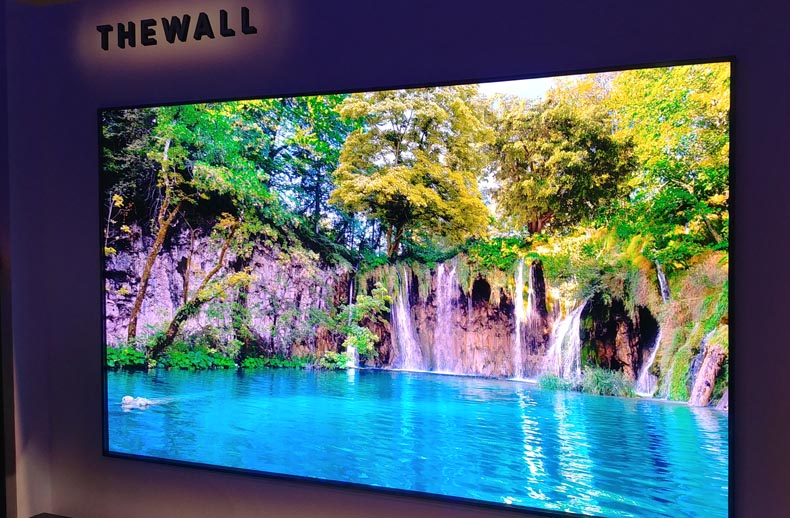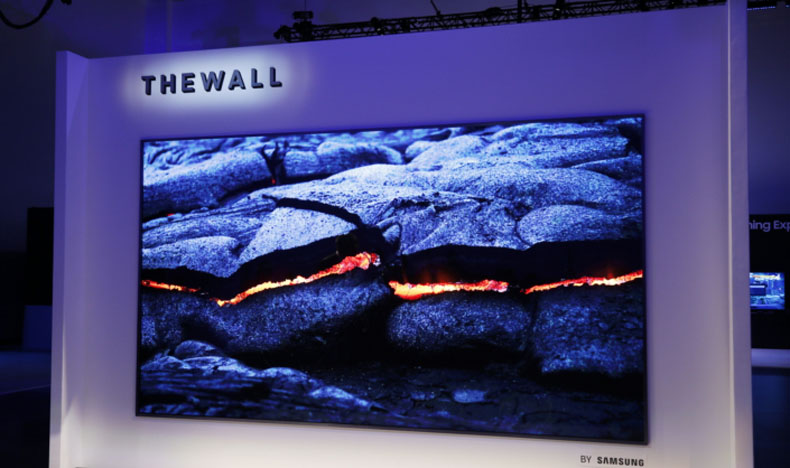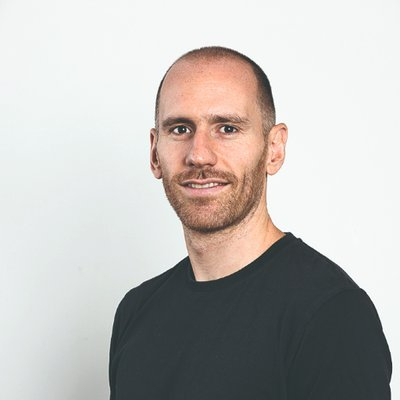
Despite addressing some of the key TV buzzwords of the day (QLED, 8K and voice control), Samsung's First Look event was a somewhat underwhelming affair compared to previous years.
The Korean TV giant announced that 8K QLED TVs with AI and Bixby voice control are on the horizon, and the curtains were raised on a 146-inch modular TV called The Wall - but Samsung’s actual 2018 TV line-up won’t be announced until spring.
So what do we know?
The Wall TV can transform to any size thanks to its modular architecture and features a self-emissive pixel technology the company is calling MicroLED. It sounds an awful lot like OLED technology to us, and will mark the first time Samsung has moved away from LCD. It will be available later this year, and while pricing wasn’t touched upon, we’d eat an HDMI cable if it isn’t at least five figures.

The 8K QLED TVs, meanwhile, will be able to upscale any source to 8K, and will be launched internationally, starting with Korea and the US, during the second half of this year.
Bixby voice control – Samsung’s answer to the likes of Amazon Alexa and Google Assistant – will also be part and parcel of the 2018 TV line-up, although a Samsung spokesperson said Bixby probably wouldn’t feature on UK models at launch.
As Samsung is one of the three founding members of the HDR10+ Alliance (alongside Panasonic and 20th Century Fox), it’s no surprise that the Dolby Vision-rivaling HDR10+ format will also be a feature of its 2018 TV line-up.
The latest hi-fi, home cinema and tech news, reviews, buying advice and deals, direct to your inbox.
Samsung's 2018 TVs will also offers its TV mobile apps under Samsung’s SmartThings umbrella, and see the launch of Universal Guide – an advanced program guide which automatically recommends TV programs and content according to a user’s preferences.
Samsung only spoke vaguely about QLED technology, but a few months ago it revealed a key change for its future QLED TVs concerning backlighting. While Samsung’s 2017 QLEDs were edge-lit, the 2018 models are set to feature direct, local-dimming backlighting instead, allowing the brand to push brightness to over 2000 nits.
Our demo proved that the technology offered significant improvement on 2017 models, delivering particularly impressive black level performance – an aspect of the picture which let down the QLED models we saw last year. While Samsung’s QE55Q7F and QE65Q7F TVs impressed us, and stand as a good advert for QLED technology, their sacrificing of black level performance for colour vibrancy, alongside slight motion and viewing angle issues, proved slightly concerning.
Elsewhere Samsung also talked about a concept version of a TV featuring direct backlight with a startling 10,000 local-dimming zones, which would be in a league of its own when it comes to brightness.
Last but not least, the next generation of Samsung TVs could be powered more efficiently. According to Samsung, the One Connect box will be around twice the size as the one supplied with 2017’s models – but that's because it’s taken on an additional job: powering the screen.
While last year’s models required a cable to the screen and another to the One Connect box, only the latter needs powering this time. It sends power and the AV signal using an umbilical cable that’s just as impressively thin as on last year's box.
We look forward to hearing more about Samsung TVs later in the week and hopefully seeing some in action.
Read more:
Panasonic reveals two 4K HDR OLED ranges ahead of CES 2018
LG to unveil world’s first 8K OLED TV at CES 2018
HDR10+ gets logo, gains more industry support
Samsung 2017 TVs, 4K, QLED, HD – everything you need to know

Joe is the Content Director for What Hi-Fi? and Future’s Product Testing, having previously been the Global Editor-in-Chief of What Hi-Fi?. He has worked on What Hi-Fi? across the print magazine and website for almost 20 years, writing news, reviews and features on everything from turntables to TVs, headphones to hi-fi separates. He has covered product launch events across the world, from Apple to Technics, Sony and Samsung; reported from CES, the Bristol Show, and Munich High End for many years; and written for sites such as the BBC, Stuff and The Guardian. In his spare time, he enjoys expanding his vinyl collection and cycling (not at the same time).
